Photo - decorative plaster in the interior of various rooms. The technology of applying decorative plaster. Wall decoration with textured plaster
Plaster, as a method of wall decoration, has been used for a long time, since the Renaissance. In those days, the style of their decoration, called frescoes, was born.
This wall painting, which has come down to our times, cannot leave anyone indifferent. Modern decorative plaster for interior decoration, in hand good master, capable of creating masterpieces that are not inferior to frescoes.
Our article will discuss what types of decorative plasters exist today, and what aesthetic effects can be obtained from their use.
According to the binding element, decorative plasters are divided into water and polymer. What is water - everyone understands.
So:
- Polymer plasters can be based on polyurethane. They can be used for both outdoor and indoor decoration.
Another type of polymer composition, epoxy, is used only indoors. - Plaster compositions are also classified according to other criteria: according to the material used as a filler, as well as the method of applying and forming a pattern.
- Due to the fact that polymer mixtures can release toxic substances, finishing apartments with decorative plaster based on polyurethane and epoxy resins is undesirable. For this, it is better to use water-based options.
Water plasters can be acrylic, styrene-butadiene, PVA-based. - According to the type of the resulting surface, the plasters also differ. The most popular are pebble.
Granite, marble or quartz chips are used as a filler for them.

- As a bonding base, cement is more often used here, because pebble plaster is used, mainly for. The filler, as a rule, is sold separately from the mixture itself, and is added to only the last batch of mortar for applying the finishing layer.
But it's on sale ready-made options plaster based. - The most environmentally friendly can be considered mineral plaster, which includes: white cement, lime, granular marble and various minerals. This material has good thermal insulation properties.
- It is used more often for outdoor decoration, but sometimes it fits well into the interior of the premises. The well-known "bark beetle" can be attributed to the mineral types of decorative plaster.
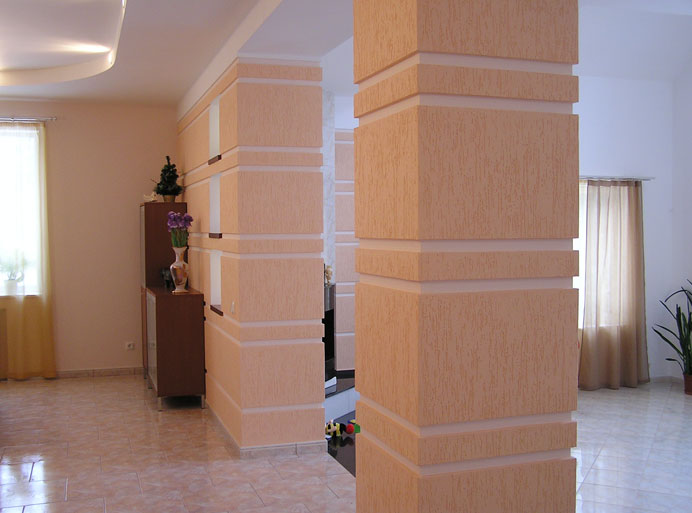
- Spectacular paintings and stunningly beautiful drawings on the wall are created using the so-called structural plasters. Their solutions are incredibly plastic, so working with them is a pleasure.
The image can be sculpted as if from plasticine. - Structural plasters are available only in white - pigments are sold separately, so that the solution can be tinted as you wish. The finished coating can be washed using detergents, it will retain its color and pattern for a long time.
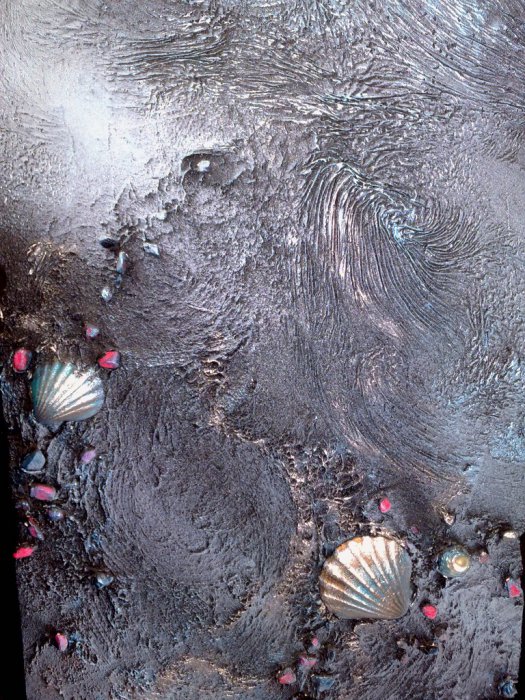
- Venetian plaster is decorative for interior decoration, the most difficult to perform. Accordingly, its price is the highest.
In common parlance, it is called liquid marble. And this is true. Since the filler for such plaster is marble flour and gypsum of the finest grinding. - The surface of Venetian stucco recreates the natural beauty and rich palette of marble shades, which makes any room acquire a rich interior, similar to an ancient palace. It is almost impossible to do such work with your own hands.
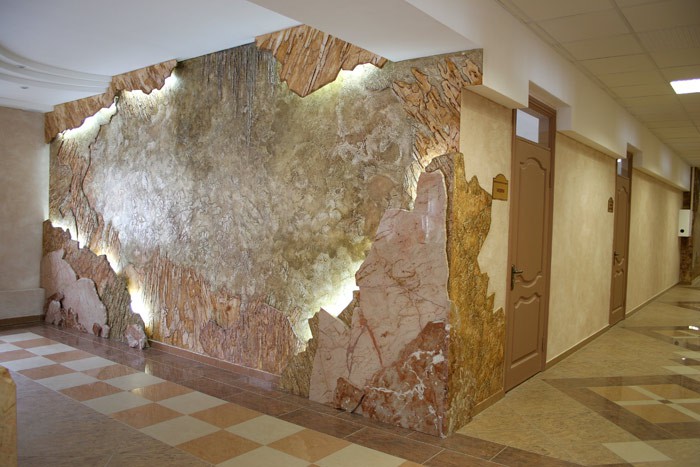
- You need to know the technology of applying plaster, and it is very complex, at least six to seven layers. You also need to have professional skills and creative imagination, which allows you to create unique drawings.
These are masterpieces, in the truest sense of the word, since even the master himself cannot repeat the same pattern twice. This is Venetian plaster. - There are some other types of modern plaster mixtures that do not fit into any of these categories. For example: microcement plaster. By and large, it is an analogue of Venetian plaster, but cheaper.
- The pattern created with microcement plaster looks similar to the Venetian version, but this mixture does not contain gypsum and marble, but cement and polymers. Due to this, microcement plaster can also be used for, as well as in rooms with high humidity.
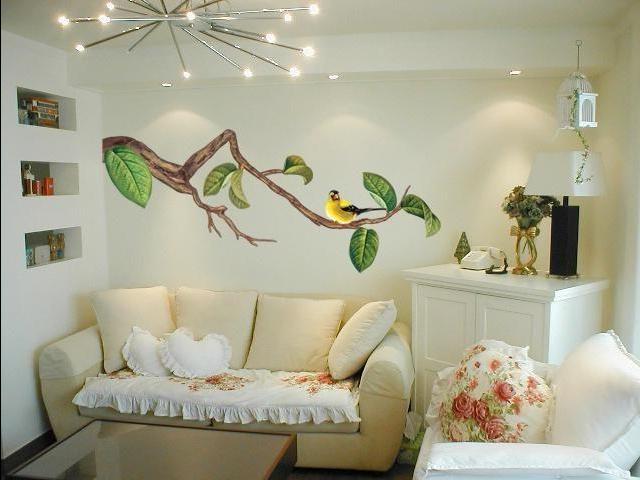
most accessible to self-finishing kind, is a soft decorative plaster, popularly called "liquid wallpaper". They are based on loose cellulose, or silk threads, CMC glue and pigment.
With good imagination and adherence to a certain technology, on the walls and with the help of liquid wallpaper, you can create beautiful compositions, as in the photo above.
Relief creation
The technology of finishing with decorative plaster, like any other, begins with surface preparation. The old coating is removed, and the walls are cleaned to brick or concrete - depending on which house.
Wet cleaning is carried out in the room, dust is removed from the walls with a vacuum cleaner.
Further:
- Masking tape should be sealed all the places where the plaster should not get. The surface of the floor is covered with thick paper, or cellophane film.
The wall is treated with a primer. This is a prerequisite for ensuring good adhesion of the mortar to the wall. - Then you need to think over and choose the color you need to create your interior. Plaster mixtures are sold both in finished form and in dry form.
If it is required, for example, to finish only a niche, of course it is more convenient to take a solution ready for use.
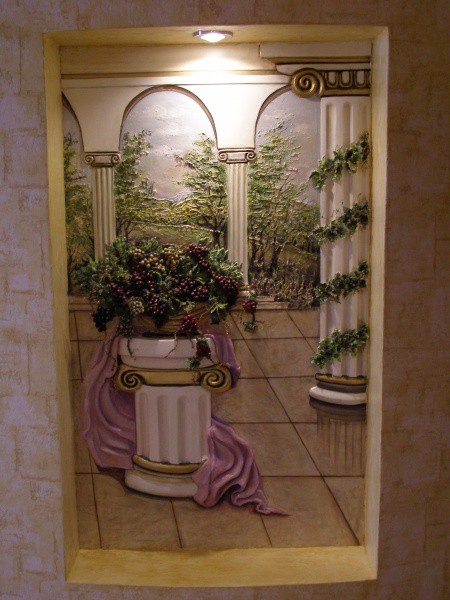
- And when finishing large areas, it will be much cheaper to work with dry mixes. They are diluted with water, in the ratio required by the instructions, and carefully knocked down with a construction mixer, to the consistency of thick sour cream.
- When working with decorative plaster, it should be remembered that a light shade is the basis for a darker color. Therefore, the first layer should be light.
The solution is applied to the wall as evenly as possible, using a rubber spatula. Although, careful smoothing, in this case, is not required.

- To create a relief, craftsmen use a variety of tools: rubber and rag rollers, figured spatulas. Any improvised means also help: rags, sponges, cellophane.
- You can even take a Christmas tree toy or a children's mask and make a trial relief. If you don't like something, you can always smooth over the drawing and make a new one.
Rubber stamps, specifically designed to create relief on the plaster, can give it the appearance of a wall pasted over with textured wallpaper.
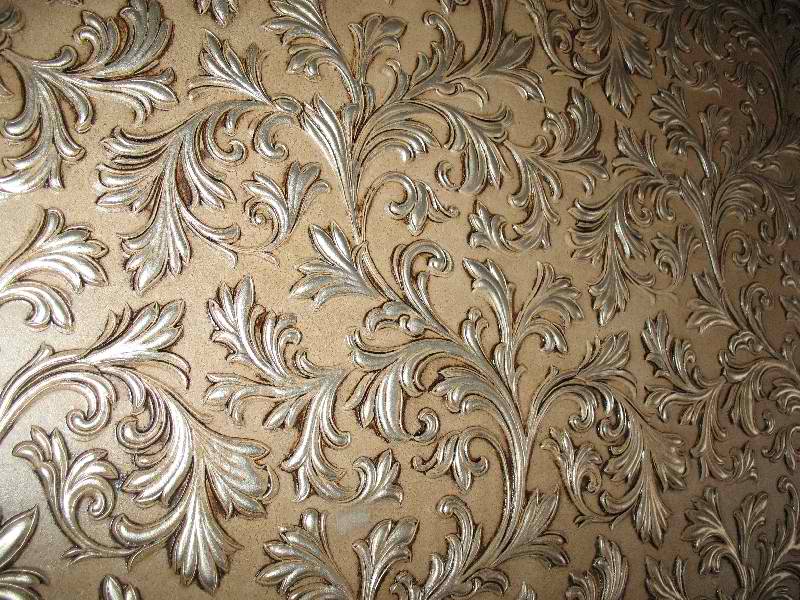
- If you want to get a clear pattern, after applying the relief, the wall must dry completely. Then a second, darker layer of plaster is applied.
It is applied in small portions and carefully smeared. - The thinner the layer, the more transparent it is, and the better the relief will be visible. And due to the fact that the second layer of plaster is darker than the first, the relief looks more voluminous.
- It is worth noting that in order to achieve the original, masters often perform more than one relief, but several. In this case, various shades of plaster can be combined, as in the picture below.

- Depending on the nature of the pattern, you can apply a second layer without waiting for the first layer to dry. Who is seriously thinking about how to do this work on their own, look at the video, how experts do it.
- Unwanted sagging or the resulting corners, they cut with a knife, grind with sandpaper. There are many nuances in this work, and each master has his own professional secrets.
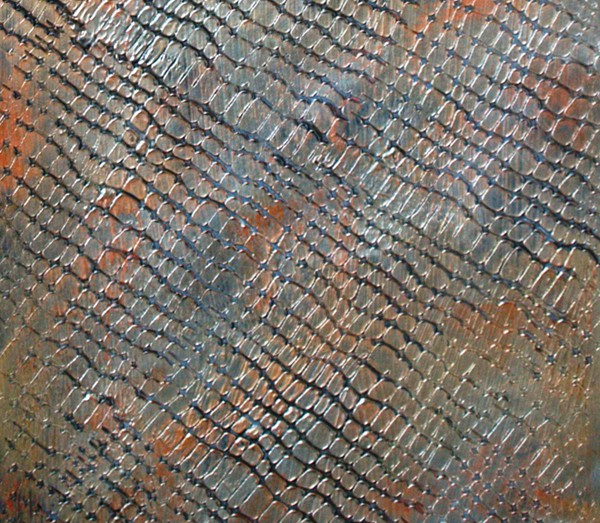
- There are many varieties of structural plasters offered by manufacturers to create a specific relief, for example: cracked old plaster, tree bark or, as in our example, crocodile skin.
In order for the finished relief to acquire durability and not be contaminated during operation, the wall must be covered with polyurethane sealant. This is done half an hour after drawing the picture.
Drawings and panels on plaster
The original panel on the wall can decorate any, even the most modest interior. That is why many people ask themselves: “How to make a panel, and where is it better to place it?”.
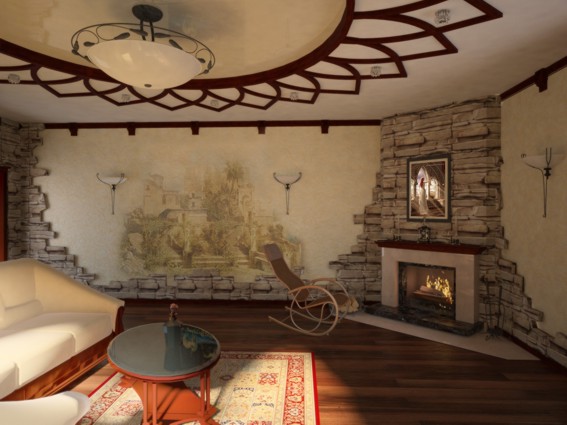
So:
- It is best if the panel is located on a protruding part of the wall or in a niche (see). Especially if good lighting is used.
An excellent choice would be a free wall framed with decorative stone or polyurethane molding. - The drawing on the wall will look great in the walls: next to the window, interior door or arch. It is permissible to cover all the walls of the room with a pattern only in one case - if it is a children's room.
Naturally, the theme of landscapes and drawings, in this case, is more often associated with cartoon characters and fairy-tale characters.
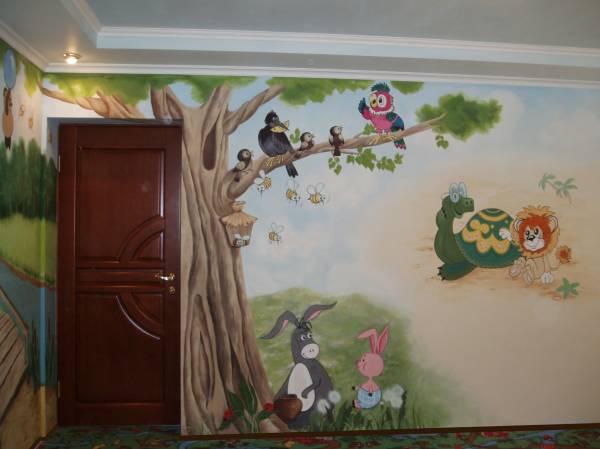
- A decorative panel, like no other finishing material, catches the eye, causes delight, a desire to touch and make sure that it is regular wall. The choice of pattern when creating a panel is not limited by anything - you only need good taste.
And, of course, the drawing should not cause disharmony in the overall concept of the interior. - In order to understand how the wall panel is made, and the interior decoration with decorative plaster - videos and photos found on the Internet will indispensable assistants. And we, for our part, will also try to help you understand this issue.
- There are three types of techniques for creating a visual effect on plaster. The simplest, and most accessible for self-creation, is a three-dimensional stencil panel.
As a stencil, a piece of drywall, hardboard, or plywood can be used, with a pattern or pattern cut out on it. - On a leveled and dried wall surface, with masking tape, around the perimeter, fix the stencil. On vertical surfaces, there is a possibility of stencil shifting.
This can spoil the nuances and subtleties of the picture. Therefore, instead of masking tape, you can use aerosol glue to fix the stencil. - A plaster solution is applied to the cut out elements of the stencil. The larger its layer, the more voluminous the drawing will be. After that, the stencil is carefully removed.
Your creation should now be completely dry. The time required for this depends on the thickness of the applied layer of plaster, but no more than a day.

- After drying, the convex parts of the panel are shaded with tinted paint, rolling over them with a roller. Then, when the paint dries, you can give them a darker shade, make it metallic or pearlescent.
Such panels are often performed on the ceiling, in combination with plaster moldings. - Another very popular type of decorative wall decoration is painting on structural plaster and relief graphics. For this, plastic fine-grained plasters, acrylic paints and colorless varnish are used.
Sharpened wooden sticks, different-sized brushes, sponges, cardboard templates and narrow spatulas are used as tools.
![]()
- Many people know how to draw well on paper, it costs them nothing to make the same drawing on wet plaster with a sharp object. For those who do not know how to draw, there are paper templates.
To create a texture on the panel, special rollers are used. Paint the panel after it is completely dry. - The third type of decorative finishing on plaster is stucco panels, and various combined options. They are three-dimensional figures, or whole paintings, made in the entire wall.
- Such panels can imitate brick or stonework, depict figures of people and animals, flowers and various objects. This is the most complex type of decoration, and without the participation of a specialist it is hardly possible to perform it.
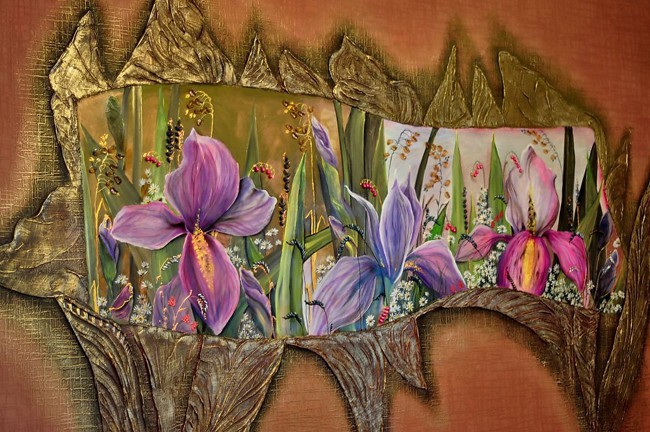
Such work, especially if it is done by an artist, is not cheap, but the aesthetic impression it makes is worth the money, believe me. Decorative finishes made in this style will delight all the inhabitants of the house for many years, and will never go unnoticed by the guests who have visited it.
The main task of carrying out repairs in the house is to create a comfortable, cozy and exclusive home. Thanks to modern materials, this can be done without the help of professionals. One of the best options is decorative plaster.
Application area:
- for exterior decoration (facade mixtures);
- for interior decoration;
- general mixes. Suitable for finishing residential and non-residential premises outside and inside.
Classification of decorative plasters by composition
- mineral. This is a dry mixture created on the basis of cement, which is diluted with water and used for exterior decoration. Among other types of decorative plasters, mineral mixtures compare favorably with their ease of application and the ability to solve the problems of additional insulation of the building facade. To impart water-repellent properties, polymer additives are introduced into the composition of the mixture. However, the service life of such material is low - 9-10 years, after which it becomes necessary to carry out work to update and restore the coating.

- acrylic. High elasticity of the material is achieved through the use of acrylic resins. The service life of such a coating is 15-20 years. However, if basalt wool is used as a house wall insulation, acrylic plaster is not recommended. The maximum manifestation of the properties of the mixture is possible when combined with a foam insulation layer.

- silicate. To date, this is the most best option finishing, having a high level of strength, and a rock service life of about 20 years. The binding component is liquid potassium glass. This type of plaster has a furrowed or evenly rough structure. Experts recommend applying silicate mixtures to surfaces containing lime.

- silicone. The main of such mixtures is an aqueous dispersion of silicone resin. Considering the fact that I use oil, silicon, table salt in the production of silicone, compositions based on them have all the advantages of mineral and polymer plasters and are among the best in the list of modern finishing materials. They are characterized by exceptionally high strength, water, dirt and dust repellent properties. The service life of the silicone mixture can reach 25 years, while the material does not absorb or accumulate harmful substances.
Decorative plasters also differ in the type of mineral filler, due to which the necessary surface relief is created. Quartz, granite or marble chips and mixtures based on them can act as a filler. The granules may have a size from 0.5 mm to 5 mm. Also, plaster compositions differ in the method of application, which determines whether the surface will be smooth or embossed, matte or glossy. Which plaster is better, it's up to you.
All compositions have a sufficient degree of vapor permeability - the ability to pass moisture and air in both directions. Acrylic compositions have the lowest vapor permeability, but at the same time they are the most weather-resistant materials. The highest rates are for silicone and silicate mixtures.
Types of decorative plasters
- textured (structural). To date, this is the most common type of finishing materials, which is sold in the form of a ready-made mixture or powder (diluted with water). The mixture is based on binders, the fillers are flax or cotton fibers, crumbs of natural or artificial materials, etc. Textured mixtures allow you to imitate masonry and wild stone, a bas-relief with an textured or three-dimensional pattern, and tree bark. The most extensive group of materials are relief coatings applied using different techniques and materials (pastes, varnishes, paper, etc.). Such plaster not only gives the surfaces a special appeal, but also perfectly hides irregularities and other wall defects.

- smooth. With its help, you can achieve the effect of silk drapery, light sea foam, ripples on the water, "pearl" shells, etc. This texture is achieved through the use of varnishes and paints, the play of light. Smooth plasters also include artistic painting and traditional plain wall decoration.
- Venetian. With its help, you can apply a coating that will successfully imitate marble and other stone textures. The composition is applied to the wall in spots in several layers. In this case, the surface acquires a shimmering, luminous surface. To enhance this effect, beeswax is added to the finish layer. Venetian plaster looks unsurpassed in interiors made in a classic style.

- stone chips. The composition of the mixture includes small pebbles, as well as adhesive and binding materials. Stone chips can be of different colors and shades. The composition is applied evenly with a spatula. The most common types of stone chips are marble, granite and quartz. They have an excellent appearance and are able to withstand bad weather. Experts recommend using decorative plasters in office decoration on large areas, but in cottages and houses it is better to decorate small areas with them or use them to accentuate individual elements of the interior (arches, ledges, openings, niches, racks, etc.). Moreover, it is most appropriate to use stone chips in non-residential premises (corridors, bathrooms, halls, etc.). In exterior decoration, it can be used both for decorating the entire building and for accentuating individual architectural elements.
- flock coating. This is one of the latest achievements of our time. The finish is applied to the surface in three layers: first a layer of glue, then colored flakes - flocks or chips, and then a varnish coating that performs a protective function. If desired, you can mix flocks of different colors.

The undeniable advantages of decorative plasters include:
- Can be applied to almost any external or inner surface buildings - concrete, brick, wood, metal, etc.
- High resistance to mechanical stress.
- The ability to hide surface defects.
- High water resistance and resistance to aggressive environments - can be washed with any detergent, with the exception of solvent-based formulations;
- Durability.
- Affordable cost.
The final stage of the repair of the premises is the decoration of the walls. One of the most popular finishing materials is called decorative plaster. Demand creates supply! Today in stores building materials The attention of buyers is offered a large selection of high-quality putty. So, what types of decorative wall plaster are in the range?
Depending on the variety of the main connecting element, decorative putty is classified into several subgroups.
Mineral
The main binder is cement. Mineral plaster is produced in the form of dry mixes. To obtain a solution, it is necessary to mix the dry mixture with water (the appropriate proportions must be indicated on the factory packaging). Using a construction mixer or an ordinary drill with a special nozzle, the solution is mixed with a homogeneous consistency.
The key qualities are the hypoallergenicity of the material used, moisture resistance, strength, good air circulation and low cost. Unfortunately, after a certain period, cracks and chips may occur.
Acrylic
Acrylic resin (high molecular weight polymer) is the main component of this type of putty. Due to its elasticity and strength after application, it is in great demand among repair teams. One of the key features is that acrylic plaster is sold as a ready-to-use mix. It is applied on various surfaces: concrete, aluminum, brick and wood. However, it was not without drawbacks. During operation, it was noted that the acrylic type putty is characterized by low vapor permeability, and also loses its properties and cracks under the influence of active UV rays.

silicate
Links elements liquid glass. It is implemented in finished form, which is very convenient to use. Due to the component composition unsafe for human health, it is used exclusively for decorating the appearance of building facades. It is difficult to work with silicate plaster, the mixture dries quickly.
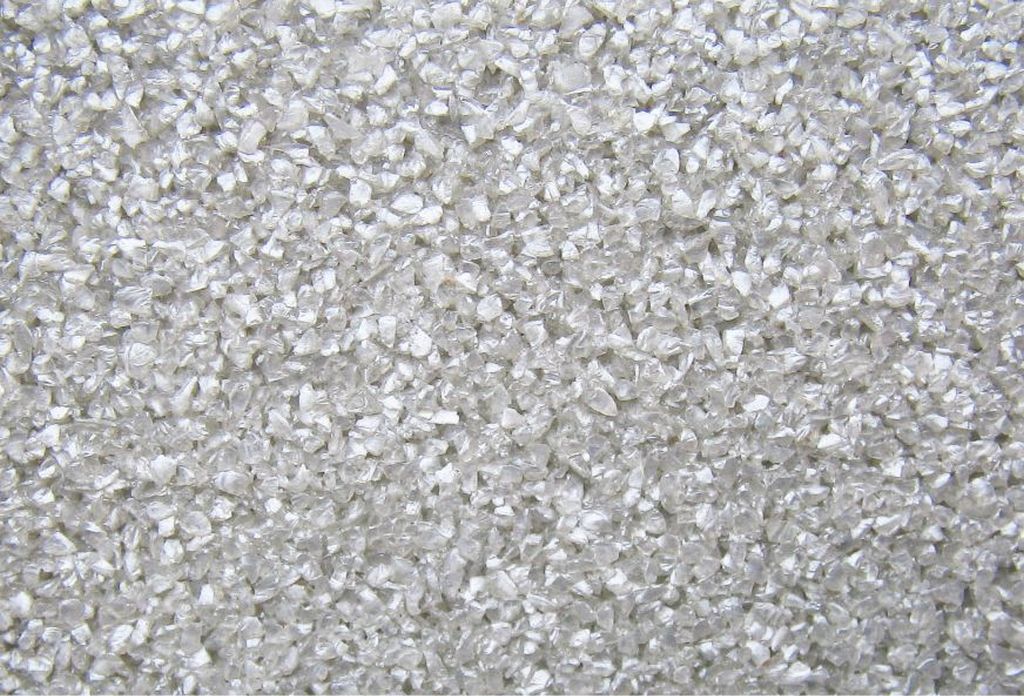
Despite some shortcomings, it has the following positive qualities: no special care is required, it is easy to clean with plain water, a high degree of fire resistance, elasticity, resistance to UV rays, dust and various contaminants.
Silicone
The basis of silicone putty is synthetic resin. A ready-made mixture of various colors is sold in specialized hardware stores. It is very popular and is used as a material for exterior and interior decoration.
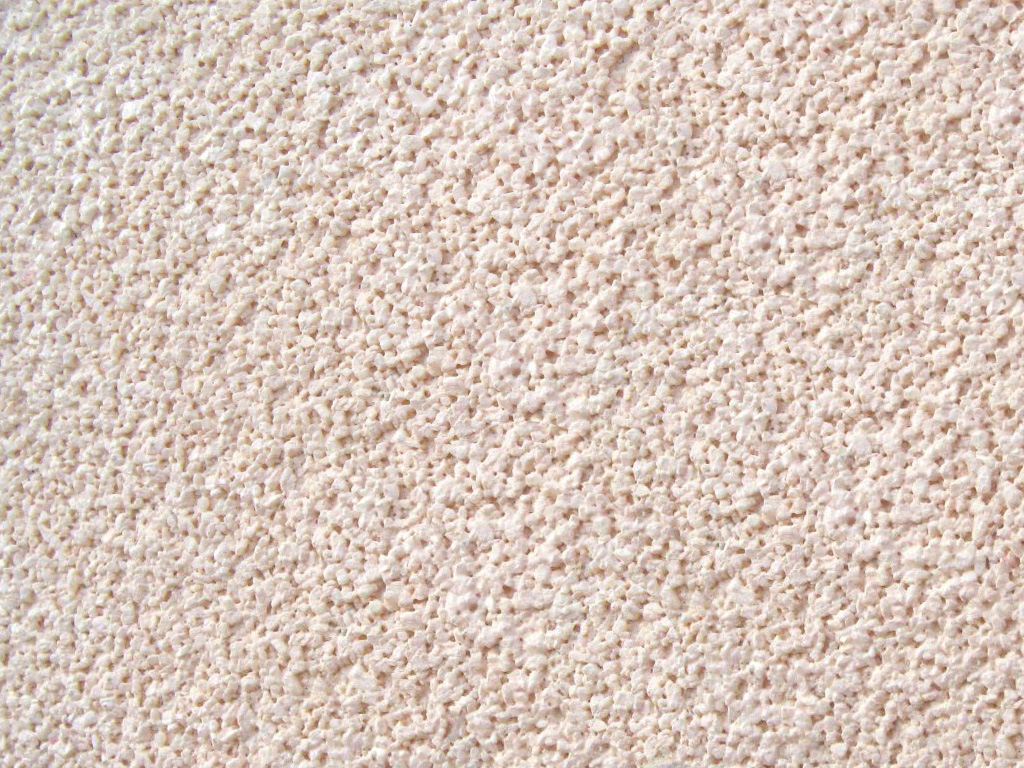
The mass is so easy to use, even a novice master can easily handle it. It has a good degree of elasticity and a high level of moisture resistance. The disadvantages include the cost of the product. Among all the above types of plaster for walls, this option is the most expensive.
Types of plaster by type of filler
Modern putty on a decorative basis may differ in the type of filler.
Textured
The basis of this material is dominated by mineral chips of marble and granite types, mica, small stones, wood and linen fibers. It is widely used for interior decoration, as well as for decorating brick, wooden and concrete walls from the outside of the building. A key feature is the elimination of various irregularities on surfaces.

Textured finishing options have a number of advantages: high moisture resistance and breathability, beautiful and stylish design. It is possible to imitate the texture of natural leather, wood, natural stone and fabric. The price range is designed for a buyer with an average income level.
Structural
A thin-layer material with a non-uniform granular texture. The basis is a silicate or acrylic mixture. It is characterized by high impact resistance, moisture resistance, resistance to various kinds of mechanical stress and temperature extremes. Craftsmen consider it an excellent material for decorating corridors and bathrooms.
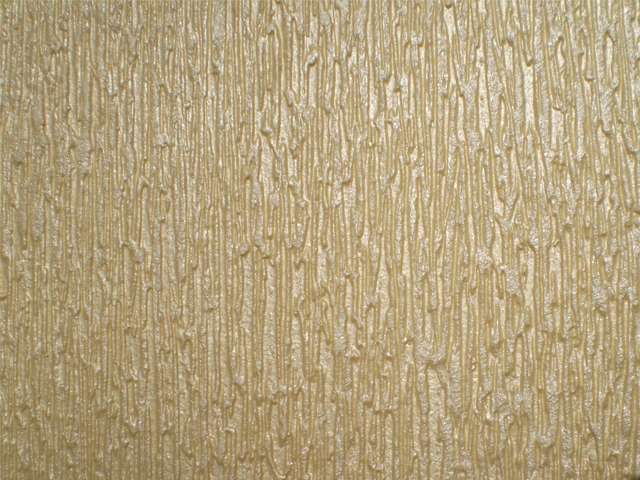
It is also applicable for finishing external facades, country houses, arbors, fences and gates.
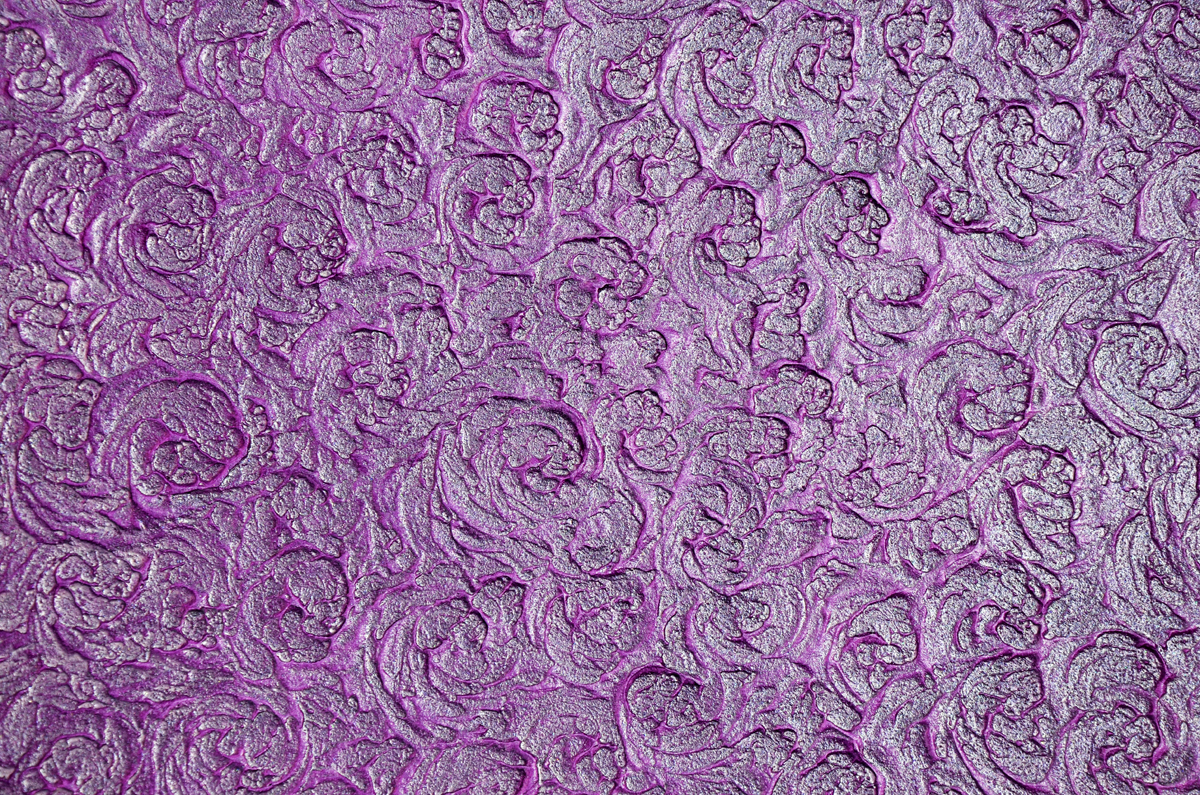
Venetian
A homogeneous structure mixture with the addition of lime and marble chips was popular back in Ancient Rome. At first glance at the wall, decorated with Venetian putty, one gets the impression that marble and onyx were used as the finishing material. For an ideal appearance, it is necessary to apply about 5-6 layers.

Each layer is applied in a thin layer. Venetian plaster requires special professionalism and experience, not every master is able to qualitatively finish the walls with this material.

Specific species
In addition to the types of putties described above, there are many other types of plaster used for interior and exterior surfaces. Less popular, but no less practical and unique, are the following options:

- Flock. Due to the addition of cellulose and silk fibers, the wall resembles a delicate silk fabric. It has excellent moisture resistance and sound insulation.
- Roller. Composed of natural materials different size roller plaster gives the walls an original appearance. After complete drying, recesses in the form of an interweaving of channels are visible.
- African. Suitable for interior decoration in ethnic style. Visually resembles the skin of a crocodile or snake. For greater effectiveness of the result, coating with varnish, paints, glitter or wax is allowed.

Advantages of decorative plaster
Due to the special texture, excellent performance and a wide variety of assortment, decorative plaster has won the sympathy of many designers.
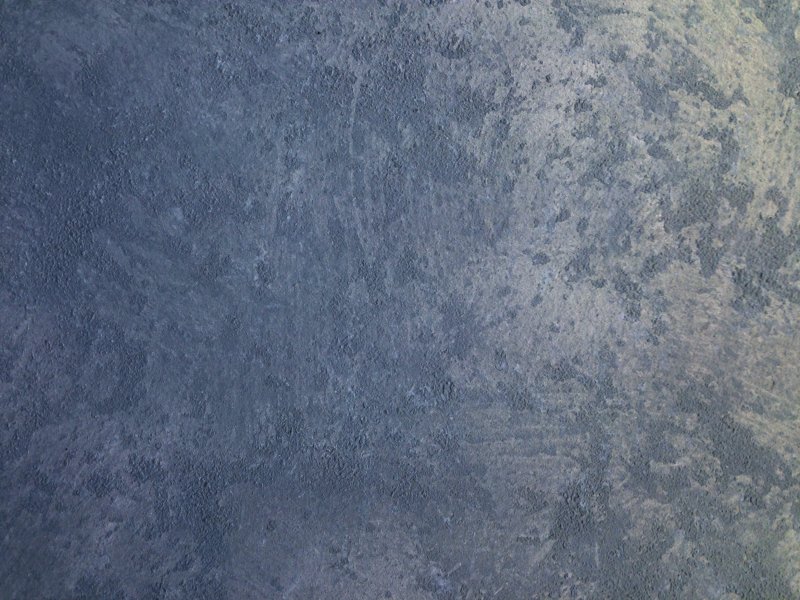
Key benefits include:
- leveling of irregularities;
- elimination of defects (cracks, chips, indelible dirt) on the walls;
- excellent sound-absorbing characteristics;
- moisture resistance and resistance to temperature extremes;
- good breathability;
- the ability to create an original and stylish design;
- resistance to mechanical stress;
- durability;
- variety of material textures.
Video "Types of plaster"
The video below highlights the main types of plaster and the features of their application
Decorative mixtures are used for the final decoration of rooms. With their help, it acquires a unique style and special aesthetics. Wallpapers are gradually becoming a thing of the past, giving way to a durable and high-quality coating that has an original structure. for interior wall decoration - everything you need to know about it, how to prepare it yourself, application instructions are in this material.
Decorative plaster coatings are classified according to several criteria. Let's consider the main ones.
By place of application
According to the field of application, the compositions are divided into:
- outdoor (for facades);
- internal (for drawing on internal walls of rooms).
Mixtures for outdoor work, in addition to the decorative purpose, pursue the goal of insulating the walls of the house. Compounds with special fillers reliably protect the joints of panel buildings from the penetration of drafts and moisture.
With the help of mixtures for interior work, you can also level the walls and prepare them for further painting or pasting. Many plasters contain fillers that give the surface an unusual interior. This coating does not require further processing.
Related article:
Video, photos, features of different mixtures, how to apply correctly with detailed instructions, an overview of prices and manufacturers, additional tips and tricks are in this article.
Composition
Coatings are classified according to their composition:
- acrylic;
- silicate;
- mineral;
- silicone.
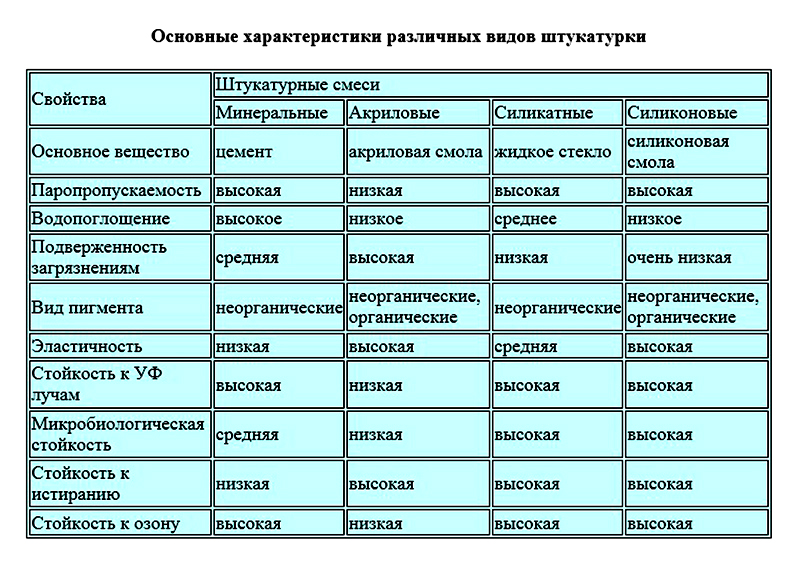
Note! The surface of mineral plaster can be smooth, rough or have a relief.
Mineral mixtures are gray or White color and are mainly used for outdoor applications. To protect the coating from exposure to atmospheric moisture, it is covered with facade paint. The composition based on the cement mixture is characterized by high fire resistance and the ability to "breathe", passing air.
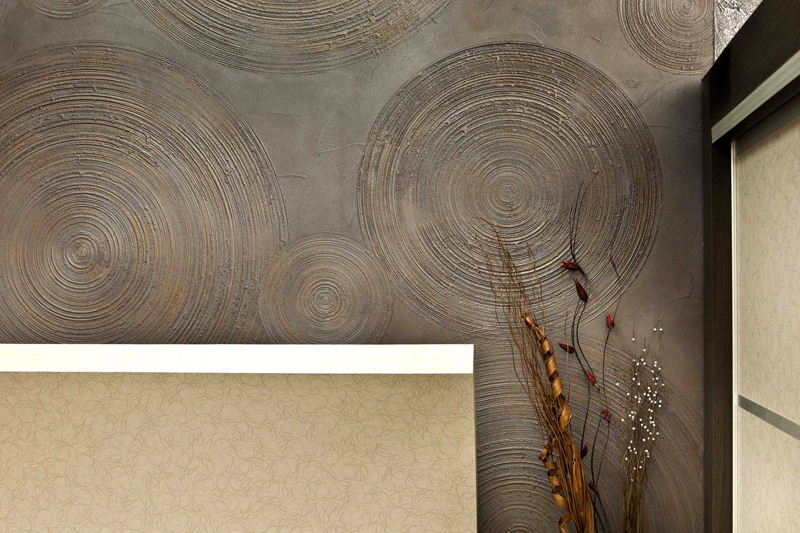
Polymer compositions based on acrylic, silicate and silicone are white monophonic or variegated, consisting of colored grains. The basis of the polymer composition after drying becomes invisible. Most plasters are made using epoxy and polyurethane.
Note! Polymer compounds are resistant to fire, but at temperatures above one hundred and forty degrees, they begin to release substances that are toxic to humans. Epoxy compositions emit chlorine, and polyurethane - cyanide. It is for this reason that water-based plasters are considered safe.

Epoxy plasters are used only for forming walls inside the building, while polymer-containing plasters can be used for exterior decoration.
Water Based Mixes non-toxic. They are resistant to abrasion and are well fixed on any surface. With the help of color, the coating can be given any shade. Acrylic coatings have increased elasticity and UV resistance. Their main drawback is a dense, non-breathable structure.

Silicone or siloxane plaster composition – newest material with silicone resin. The silicone compound forms a water-repellent elastic coating that will not crack over time. Such plaster is self-cleaning, skips carbon dioxide does not fade in direct sunlight. Walls can be washed, including alkaline detergents. Another advantage of the composition is that it does not support the development of molds.
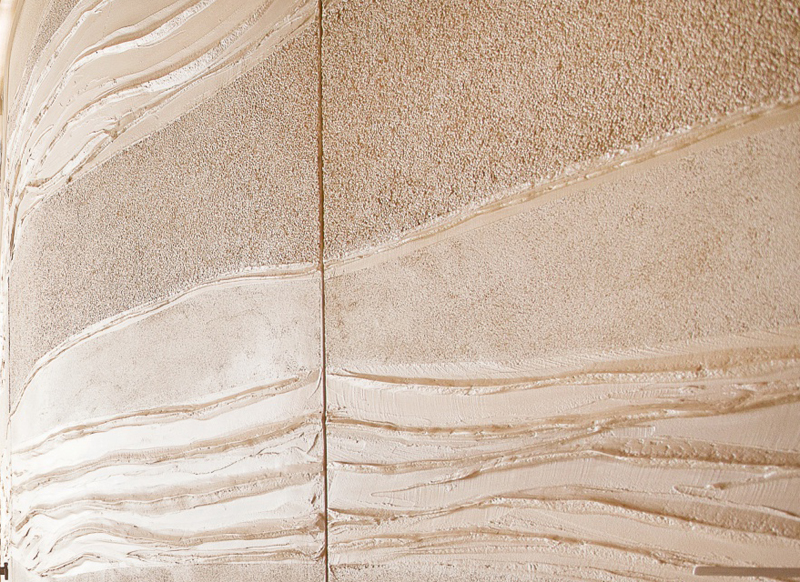
silicate plaster mixes contain water-repellent additives and well protect the wall from moisture. Their strength is based on the process of double silicification, when potassium-based liquid glass reacts with the filler and the wall surface.
Note! The silicate mixture must not be applied to walls painted with organic synthetic dyes.
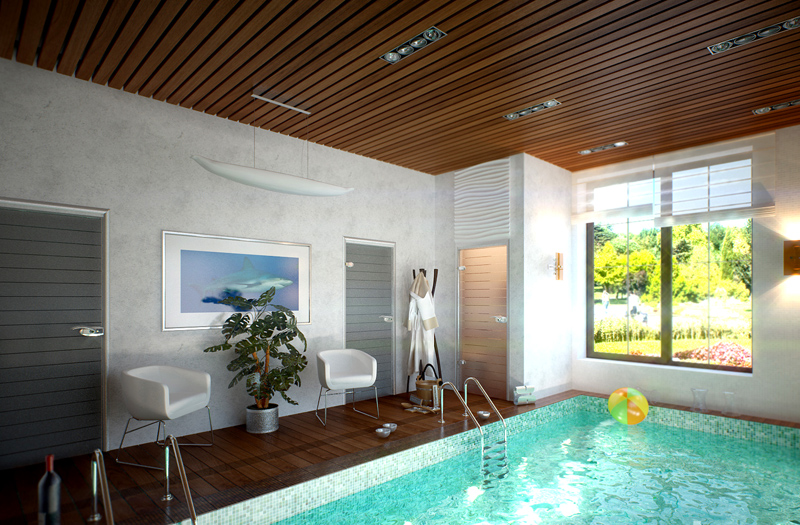
Related article:
What are they, how to make and apply them correctly, stencil templates (flowers, cats, butterflies) and helpful tips- read in the special material.
By invoice
Decorative plaster for interior wall decoration is able to imitate the texture of stone, wood, and even leather and fabric. This effect can be achieved using a special application technique and the use of an appropriate filler.

Structural mixtures contain mineral grains, granite, marble or quartz. Quartz sand gives the coating smoothness and good adhesive properties. Marble and granite filler allows you to create a rough surface that is resistant to scratches.
Note! Some plaster mixtures may contain silk or cellulose fibers. This filler allows you to imitate textiles and leather.
Plaster can be divided into three main groups according to texture:
- mixtures with a fine composition, the relief on which is applied with a roller or brush;
- compositions with filler of different sizes. When applied to them, a pattern appears in the form of stripes or furrows;
- textured mixtures with bulky filler and forming a variegated or plain surface.
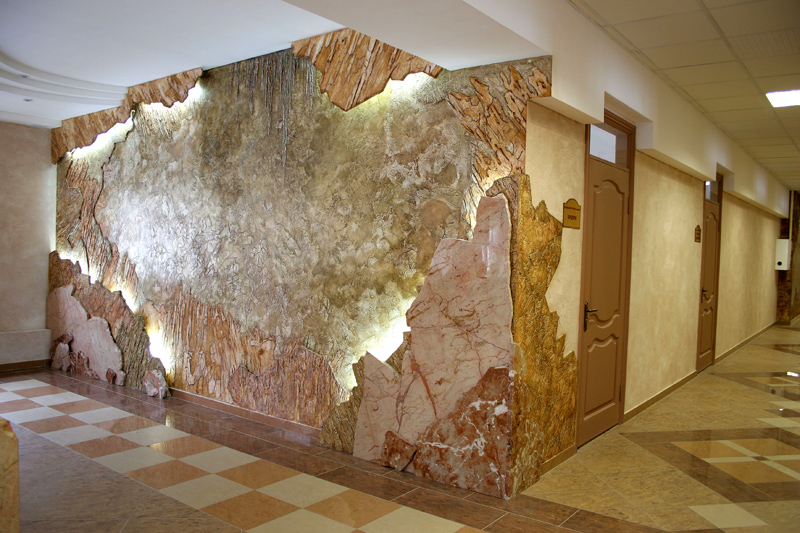
Any of the listed mixtures requires careful preparation of the walls for decorative plaster. They must be treated with primer and putty, use grout. This is a laborious process that requires professional skills.
Decorative plaster for interior wall decoration: mix manufacturers
It is conditionally possible to divide all ready-made plaster mixtures into three price categories:
As you can see, you can choose a mix option that matches your planned budget.
Advice! When purchasing a mixture, pay attention to the presence of a special safety sign. If there is an A + sign on the label, then the composition does not pose a danger to people and animals.

Options for applying decorative plaster, price per m2
| Surface | Image | Application features |
 | The relief can be created with a trowel. First, the main layer is applied, and then a small amount of the mixture is distributed with a trowel. | |
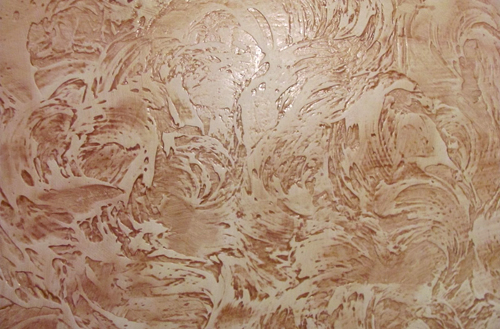 | During the design process, several layers of plaster are applied. Then the surface is painted. | |
 | On the surface of freshly applied plaster, brush several times with a stiff brush. After drying with a dry rag, excess crumbs are removed. | |
 | For such a surface, a special roller with a convex pattern is used. You can make a drawing yourself, for example, by wrapping a regular roller with a rope. | |
 | Several layers of coating with different shades are applied to the wall. After drying, the sections are cut along and the top layer is carefully removed. This is a complex technique that gives an original result. |
These are just the basic ways of applying plasters. There are many other options, including copyright ones, which give a unique effect.
The more difficult the task, the more expensive the services of the master will cost. The usual plastering of walls in a smooth way will cost from 400 rubles per square meter.

Examples of using decorative mixtures
The purpose of the premises dictates the choice of a particular composition and the method of its application. Consider the most successful interior options using decorative mixtures.
Decorative plaster in the living room: photo gallery
For a room in which the owners receive guests, it is important that everything is perfect. Here, compositions with a fine structure are appropriate, requiring careful application.
1 of 4


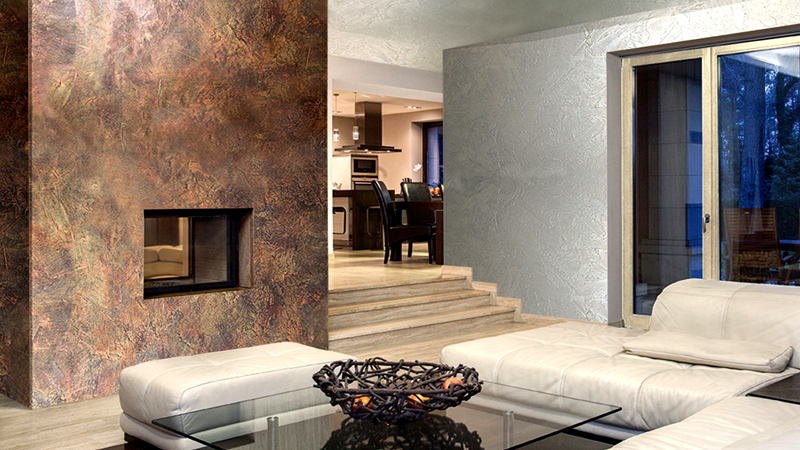

For decorating the walls in the kitchen, it is important that they do not get dirty and can withstand cleaning with detergents. Silicone mixtures in this regard are ideal.
1 of 4


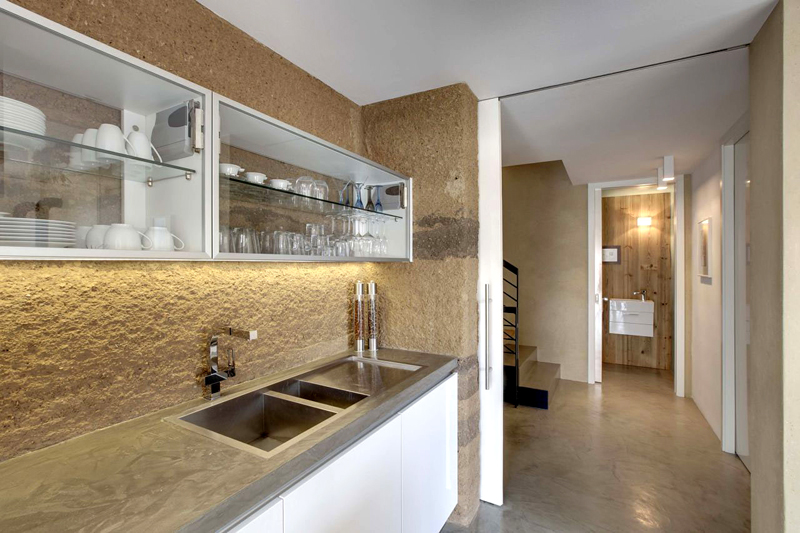

Decorative plaster in the bathroom: photos of successful solutions
Wall surfaces in the bathroom must be moisture resistant. Epoxy-based polymer compositions will reliably protect the walls from dampness.
1 of 4


1 of 4
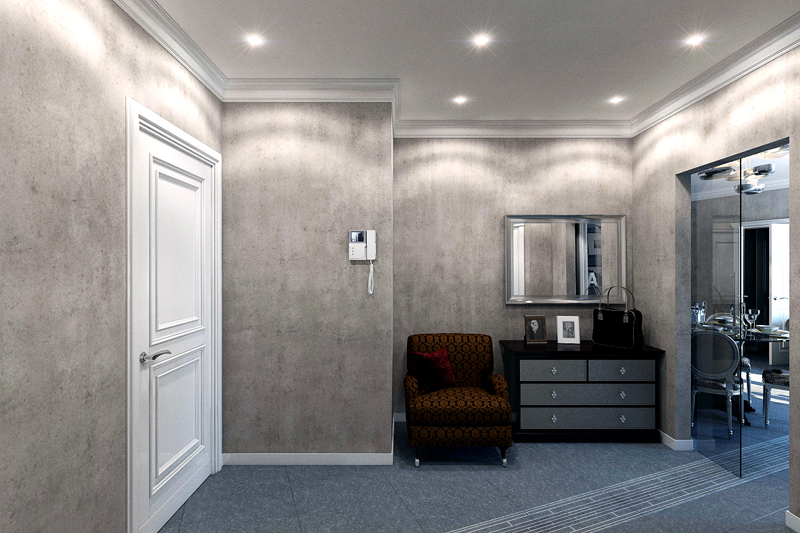

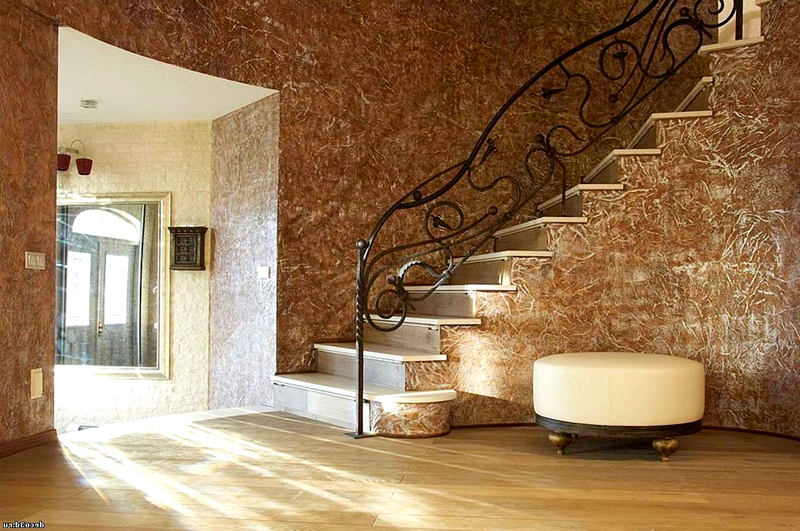
When the surface of the layer hardens a little, it can be embossed. For this purpose, a printed roller or a simple crumpled rag or paper is suitable. Volumetric drawing is created using. To align the edges of the convex structure, they are leveled with sandpaper after drying.

After the surface is dry, the wall can be painted with a brush or soft roller. detailed instructions how to apply decorative plaster on the walls in the video:
Plaster tricks
- To independently prepare a mixture for interior wall decoration, you need to mix clay, lime and fine stone chips. To make the composition durable, a primer or PVA glue is added to it.
- You can make a composition based on tile adhesive. It is suitable for imitation brickwork or natural stone. Relief patterns are well obtained from a gypsum mixture.
- A roller with a “fur coat” will allow you to create an original relief surface.
- The structure of marble will help to create a crinkled fabric or a piece of leather, which is wrapped around a working tool.
- To simulate a textile surface, a piece of burlap should be pressed against the dry plaster.
Summing up
The use of modern plaster mixtures allows you to create fashionable and modern interiors.
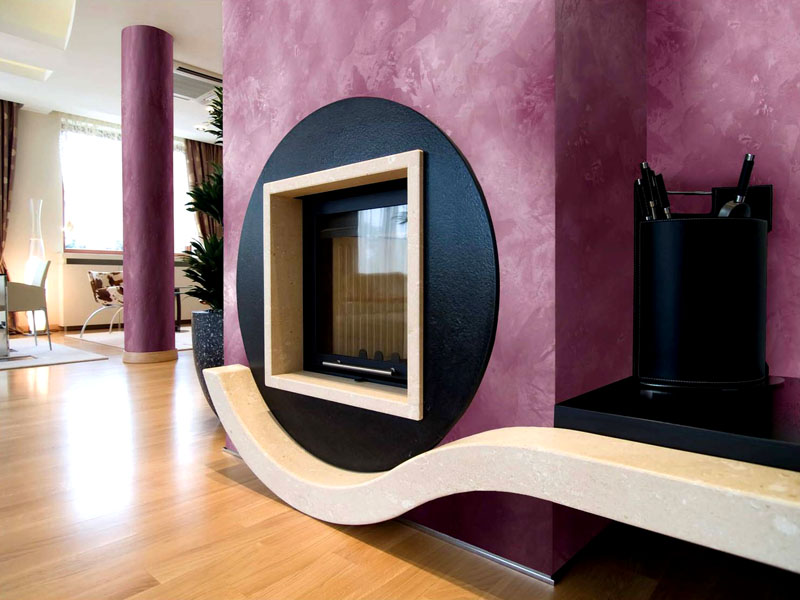
For rooms with high humidity, it is better to use polymer-based compositions. The plaster layer can be given a relief structure and imitate with its help many natural materials: stone, wood, fabric and leather. Interiors created using decorative compositions look modern and expensive.
Decorative plaster- solution for carrying out internal finishing coating of walls in residential and public buildings. The main purpose of its application is to decorate and give an aesthetic appearance to the treated surface.
Varieties of decorative plaster
Plastering of walls has been known since the Renaissance, when various kinds of frescoes were depicted on the walls. We all remember them from photos from history books. Since that time, a huge number of different types of plaster have appeared, each of which can turn the same room into a masterpiece of art. 50 years ago, plaster was used only as a leveling material, but now it is an independent coating that gives the repair a new sound. Decorative plaster is divided into several types according to the final result, these are:
- Structural
- Textured
- Venetian
If the first two types form a rough, pleasant coating, then the last type of plaster gives the treated surfaces a perfectly smooth structure.
In addition to this separation, plaster is also distinguished by the binder.
Acrylic. Here, the binder is a high molecular weight polymer such as acrylic resin. Thanks to him, the plaster is easy to apply, it is more elastic. This coating is sold in the form of a ready-made mixture of various shades, it is also possible to paint the dried surface in any color in accordance with the wishes. But often the coating cracks after several years, in addition, it has a low vapor permeability and exposure to UV rays.

Mineral. The binder of this plaster is cement. Such material is produced in the form of a dry powder, which is diluted with water before starting work. Such a decorative coating is distinguished by its strength, resistance to mechanical damage.

Silicone . The binder is synthetic resins. Very plastic and easy to apply material for interior and exterior use, which, when dried, forms a moisture-repellent film, which makes it possible to use it in the bathroom.

Silicate. The binder is liquid glass (quartz sand, alkaline potassium carbonate and potassium hydroxide). This is the most reliable and durable type of plaster, which has astringent, adhesive and impregnating properties. Prevents wall decay, mold formation and repels moisture.
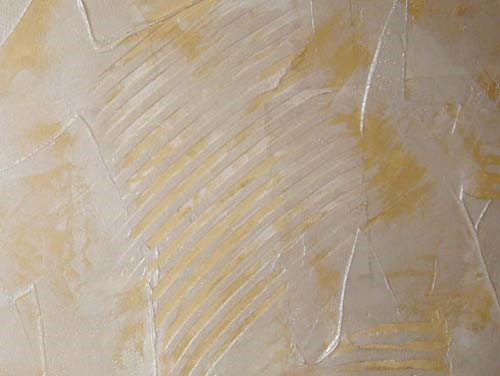
Let us consider in more detail decorative plaster by type of filler.
Structural
This is an acrylic or silicate-based material with a thin layer structure. To create a structural coating, it uses marble chips or quartz. Appearance- granular heterogeneous mass. It is divided into fine-grained plaster, which, when applied, looks almost even, as well as medium and coarse-grained, which forms a noticeable wall relief when dried.

Such plaster forms a layer that has high air permeability and resistance to atmospheric phenomena and moisture. It is applied with a roller, sprayer or spatula, the consumption rate is 3 kg per 1 sq. m. It is not allowed to add additional coloring matter to the finished mixture.
Textured
Plaster with a coarse, highly viscous structure with the addition of small pebbles, fibers, wood, mica, mineral chips. Adheres well to brick, wood, concrete and plastered substrates.
Special particles in the composition of the plaster easily mask all the irregularities of the walls. For its application, no pre-treatment is required, except for cleansing and drying. For better adhesion, it is recommended to apply an adhesive composition to the walls.
Dry coating can imitate natural stone and leather, wood or fabric. Before applying the plaster, it is possible to paint the mixture with colors of various shades. Consumption for interior decoration is relatively small - up to 2 kg per 1 sq. m. The finished coating is durable, breathable and waterproof. Such plaster walls are covered very easily and without the use of special tools, so the participation of professionals in the processing is not necessary.
Textured plaster is divided into the following subspecies:
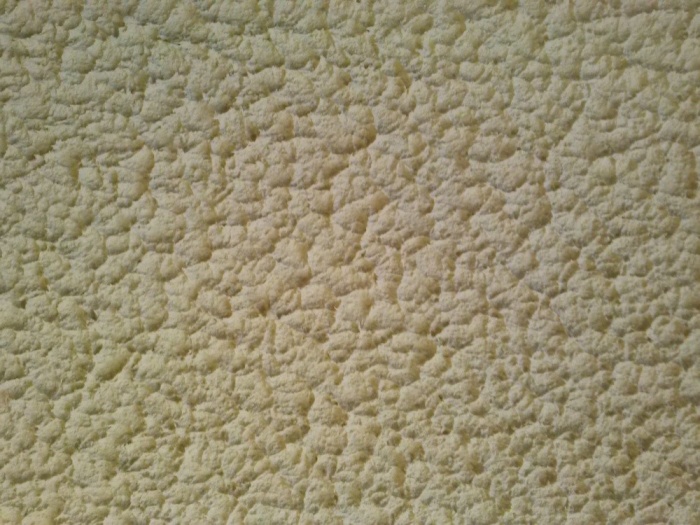
Important ! The relief appears immediately after applying textured plaster.
Venetian
This is a decorative multilayer coating with the addition of slaked lime and marble chips. The finished coating imitates natural marble or onyx. This finish can often be seen in the photo of classic and pompous interiors. It is very difficult to apply plaster with a rubber spatula in small strokes, which must be thoroughly dried. The entire finishing process is best left to professionals. Different application methods give a matte or glossy surface.
Particular attention should be paid to the preparation of the walls, they are cleaned, reinforced, puttied and primed. Only after completing all these steps, you can begin to design the coating.
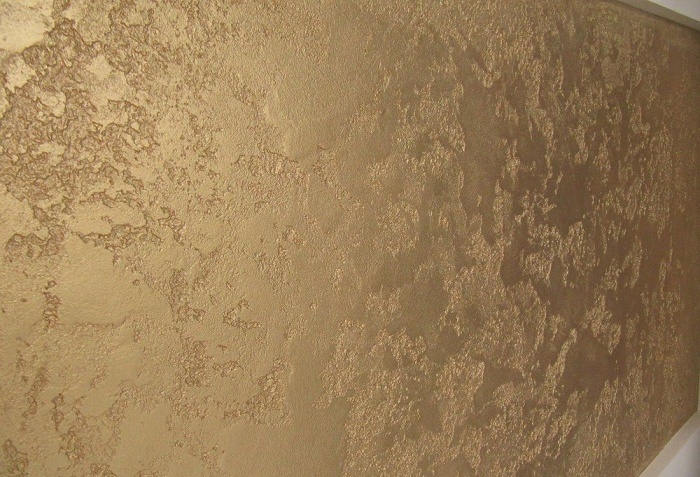
Specific types of plaster
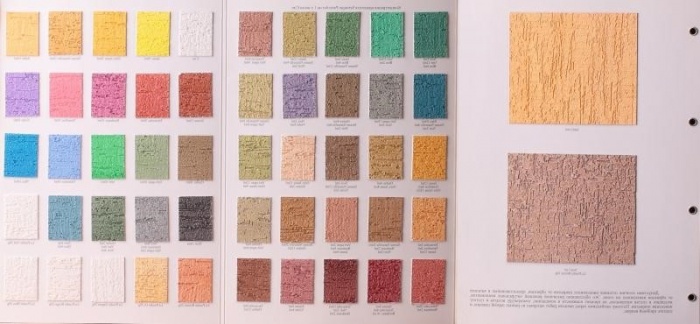
Advantages of decorative plaster
Finishing the surface of the walls of the premises with plaster is currently very popular both among those who make repairs on their own and among interior designers. And it's not just that. Decorative plaster has a lot of advantages to choose from:
- Masking bumps and imperfections
- Coating resistance to atmospheric phenomena
- No special surface treatment before application
- Moisture resistant outer layer
- Additional soundproofing
- Opportunity to realize the most daring ideas
- The resulting strong and durable coating, with a lot of positive properties.
DIY wall decoration
Covering the walls with decorative plaster is an interesting process that allows you to realize any ideas and give free rein to your imagination. It is not necessary to use the services of professionals, you can do any work with your own hands, but for this you should clearly know the goal that should be the result and follow the technology. The easiest way is to find a photo of the desired result and start from that.
First you need to process the walls: remove cement dust, peeling coatings from them, dry well.
The algorithm of actions when applying plaster differs depending on the mixture that was chosen.
Venetian plaster finish
Work is carried out in several layers:
- Plastering with a wide spatula. Strokes at this stage can be asymmetrical and wide, spaces are allowed between them. The layer is dried.
- The strokes overlap the gaps of the previous layer. The layer is also subject to drying.
- Grinding with a smooth steel tool.
- To give a glossy sheen, the walls are covered with a special varnish.
Important ! To give an interesting effect, each new layer can be a different shade.

Textured plaster finish
Here the work is done a little differently:
- The old coating is removed, the walls are dried
- The day before finishing the walls are primed.
- The plaster is applied with a soft spatula, relief is given.
- The required pattern is obtained with various kinds of decorative spatulas, rollers, stencils.
Important ! You need to cover the entire surface at once: from corner to corner.

Structural plaster finish
The composition is applied with a trowel made of stainless steel. After 2-3 minutes, the finished coating is smoothed with a circular motion with a plastic trowel, excess plaster is removed with a spatula. Here, work is also carried out from corner to corner in order to avoid the appearance of noticeable seams.
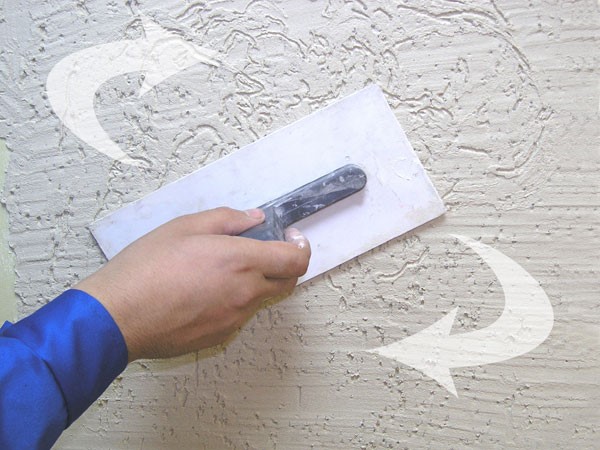
Coating care and renewal
Decorative plaster is a unique material that gives a durable coating that is resistant to various kinds of external influences. In the first year after repair, the surface does not require special care. In case of soiling, the walls can be washed with an ordinary detergent without harsh chemical fillers with a soft cloth or sponge.
To increase the service life of a dried decorative coating, wax compounds are often applied to create an additional water-repellent layer. With the help of wax, you can update the plaster, because such compositions often include mother-of-pearl and have pleasant shades.
The mixture is applied simply: with a spatula, sponge or brush in two layers, polished after drying. The surface with wax is cleaned with ordinary or soapy water, without the addition of chemicals and abrasives.
In addition to wax, you can process the finished surface of the plaster with glazing, it will also add shine and emphasize the relief forms. You can choose a suitable shade among those presented and thereby give the interior various notes. It is recommended to apply such a tool with a special mitten, if it is not available at the time of repair, then you can do with a sponge or brush. The coating is also cleaned with soapy water without aggressive agents.
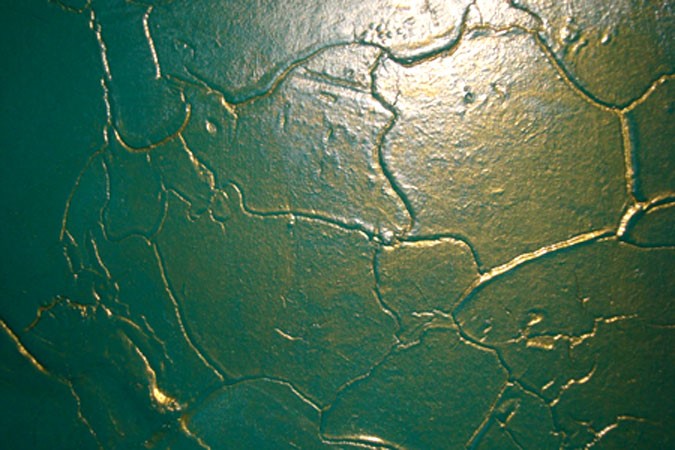
If it is necessary to completely change the interior, then the plastered layer can be painted in any desired shade, removed to the base or leveled by puttying over the finished coating, and then produce the desired finish. This may be a new layer of decorative plaster, wallpaper or other desired material.
Conclusion
Decorative plaster is an innovative material for external and internal work, which has earned immense popularity, and all thanks to unique properties, ease of repair and maintenance. This wall design will be appropriate in any room of the house, whether it be a bedroom, a nursery, a corridor and even a bathroom, but for wet rooms you need to choose the right mixture with the highest water resistance and durability. Thanks to decorative trim walls with plaster, you can save a lot of money and time, as well as discover the talent of a designer and bring to life all your plans for repairing a room.



